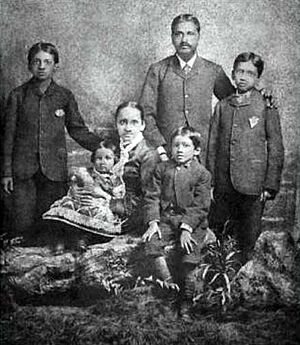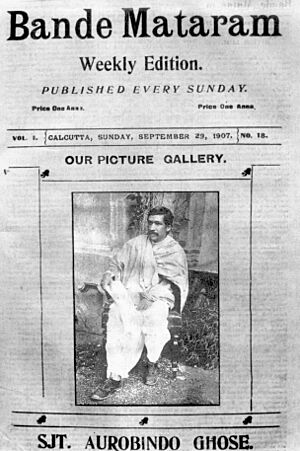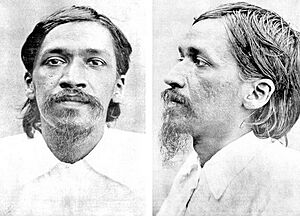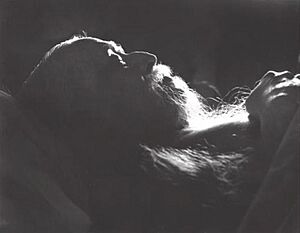Sri Aurobindo facts for kids
Quick facts for kids {{{name}}} |
|
|---|---|
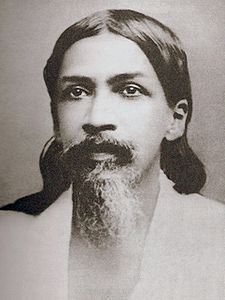
A Photograph of Sri Aurobindo
|
|
| Birth Date | 15 August 1872 Calcutta, Bengal Presidency, British India (now Kolkata, West Bengal, India) |
| Died on | 5 December 1950 (aged 78) Pondicherry, French India (present-day Puducherry City, Puducherry, India) |
| Birth name | Aurobindo Ghose |
| Philosophy |
|
Sri Aurobindo (born Aurobindo Ghose; 15 August 1872 – 5 December 1950) was an important figure in India. He was a philosopher, a yogi (someone who practices yoga), a poet, and a strong supporter of Indian nationalism. He also worked as a journalist, editing newspapers like Vande Mataram.
Aurobindo joined the movement for India's independence from British rule. Until 1910, he was a key leader in this movement. Later, he became a spiritual teacher. He shared his ideas about how humans could grow and develop spiritually.
He studied in England at King's College, Cambridge. After returning to India, he worked for the Maharaja of Baroda. He became more involved in politics with the Indian National Congress and a revolutionary group in Bengal. He was arrested in a case known as the Alipore Conspiracy. He was accused of treason, but he was only found guilty and jailed for writing articles against British rule. He was released when there was no evidence against him.
While in jail, he had deep spiritual experiences. After this, he moved to Pondicherry, leaving politics behind to focus on spiritual work. In Pondicherry, Sri Aurobindo developed a spiritual practice called Integral Yoga. He believed that human life could evolve into a divine life. He thought that spiritual growth could not only free people but also change human nature. This would allow a divine life to be lived on Earth. In 1926, he founded the Sri Aurobindo Ashram with the help of his spiritual partner, Mirra Alfassa (known as "The Mother").
His most famous books include The Life Divine, which explains the ideas of Integral Yoga. Synthesis of Yoga talks about the methods of Integral Yoga. Savitri: A Legend and a Symbol is a long poem he wrote.
Biography
Early Life and Education
Aurobindo Ghose was born in Calcutta (now Kolkata), India, on 15 August 1872. His family was Bengali. His father, Krishna Dhun Ghose, was a surgeon. His mother was Swarnalata Devi. Aurobindo had two older brothers, Benoybhusan and Manmohan, a younger sister, Sarojini, and a younger brother, Barindra Kumar.
Young Aurobindo grew up speaking English. His father believed British culture was better. So, Aurobindo and his two older brothers were sent to a boarding school in Darjeeling. This helped them improve their English.
Studying in England
In 1879, Aurobindo's family moved to England. His father wanted his sons to join the Indian Civil Service (ICS). This was a very important group of about 1000 people who helped run British India.
The three brothers lived with Reverend W. H. Drewett in Manchester. They learned Latin from him. In 1881, his older brothers went to Manchester Grammar School. Aurobindo continued his studies with the Drewetts, learning history, Latin, French, geography, and math.

In 1884, Aurobindo and his brothers moved to London. Aurobindo joined St Paul's School. He learned Greek and spent time reading English literature and poetry. He also learned some German and Italian. He knew many languages by the time he was an adult.
By 1889, Aurobindo was the only brother who could still try for the ICS. He won a scholarship to King's College, Cambridge. He passed the written ICS exam, ranking 11th out of 250 students. However, Aurobindo was not interested in joining the ICS. He purposely failed the horse-riding exam to avoid being selected.
In 1893, he left England for India. His father, who was waiting for him, sadly heard a false report that Aurobindo's ship had sunk. His father died after hearing this news.
Work and Politics in India
In Baroda, Aurobindo started working for the state government in 1893. He did various jobs, including teaching French at Baroda College. He later became the vice-principal. In Baroda, Aurobindo taught himself Sanskrit and Bengali.
He became very interested in the movement for India's independence. He worked secretly with resistance groups in Bengal and other states. He met important leaders like Lokmanya Tilak.
Aurobindo often traveled between Baroda and Bengal. He wanted to connect with his family and help set up resistance groups. In 1901, he married Mrinalini, who was 14 years old. She passed away in 1918 during the influenza pandemic.
In 1906, Aurobindo became the first principal of the National College in Calcutta. This college aimed to provide education for Indian youth. He resigned in 1907 because he was very busy with political activities.
Aurobindo was inspired by stories of rebellions against England in other countries. In public, he supported peaceful resistance. But in private, he also took part in secret revolutionary activities.

In Bengal, he helped inspire revolutionaries like Bagha Jatin. He also helped create youth clubs, including the Anushilan Samiti in 1902.
Aurobindo attended the 1906 Indian National Congress meeting. He helped set goals like "Swaraj" (self-rule) and "Swadeshi" (using Indian goods). In 1907, he was a leader of the "extremists" at the Surat Split of the Congress, which caused the party to divide.
In May 1908, Aurobindo was arrested again in connection with the Alipore Bomb Case. He was put in solitary confinement in Alipore Jail. The trial lasted a year. He was found not guilty on 6 May 1909. His lawyer was Chittaranjan Das.
From Politics to Spirituality
While in jail, Aurobindo had powerful spiritual experiences. These experiences completely changed his view of life. His goal became much bigger than just freeing India.
He said he felt a great sense of calm when he first returned to India. He began practicing yoga without a teacher. In 1907, he met a yogi named Vishnu Bhaskar Lele. This yogi taught Aurobindo to rely on an inner guide.
In 1910, Aurobindo stopped all political activities. He went into hiding in Chandannagar. The British government was trying to arrest him again for an article he wrote. On 4 April 1910, he moved to Pondicherry, which was a French colony at the time. The arrest warrant against him was then withdrawn.
Life in Pondicherry
In Pondicherry, Sri Aurobindo focused on his spiritual and philosophical work. In 1914, he started a monthly magazine called Arya. He wrote many articles for it, which were later published as books. These included The Life Divine and The Synthesis of Yoga.
At first, he had few followers in Pondicherry. But over time, more people joined him. This led to the creation of the Sri Aurobindo Ashram in 1926. From 1926, he began to sign his name as Sri Aurobindo.
He wrote many letters to his students, explaining his teachings. These letters were later collected into books. In the late 1930s, he started working on a long poem he had begun earlier. This poem, Savitri, became his greatest literary work. It is an epic spiritual poem with about 24,000 lines.
On 15 August 1947, Sri Aurobindo strongly disagreed with the partition of India. He hoped that the nation would not accept it as a final decision.
Sri Aurobindo was nominated twice for the Nobel Prize, once for Literature in 1943 and once for Peace in 1950, but he did not receive either award.
Sri Aurobindo passed away on 5 December 1950. Many people, including the Indian Prime Minister Jawaharlal Nehru, praised him for his contributions to yoga and the independence movement.
Mirra Alfassa (The Mother)
Mirra Alfassa, known as The Mother, was Sri Aurobindo's close spiritual partner. She was French, born in Paris in 1878. She came to Pondicherry in 1914 and settled there in 1920. Sri Aurobindo saw her as his equal in spiritual work.
After 1926, when Sri Aurobindo went into seclusion, he left it to The Mother to manage the ashram. She planned and built the community of students who gathered around them. She also started the Sri Aurobindo International Centre of Education. After Sri Aurobindo died in 1950, she continued their spiritual work and guided their students.
Philosophy and Spiritual Ideas
Integral Yoga
Sri Aurobindo's spiritual system is called Integral Yoga. He wrote about it in his books, The Synthesis of Yoga and The Life Divine.
He believed that the divine (God, or Brahman) creates the world we see. He did not think the world was an illusion. Instead, he believed the world could evolve and become a new world with new species, just as humans evolved from animals. He thought that the goal of spiritual practice was not just to escape the world, but to bring the Divine into the world to transform it. This was the purpose of Integral Yoga.
Sri Aurobindo believed that Darwinism (the theory of evolution) only describes how matter evolves into life. He thought that life is already present in matter because everything comes from Brahman. He argued that nature has evolved life from matter and mind from life. He believed that everything in existence is trying to reach a higher state called the Supermind. He felt that evolution has a purpose.
The Supermind
At the heart of Aurobindo's ideas is the Supermind. This is a special power that connects the unmanifested Divine with the world we see. Aurobindo said that the Supermind is not completely separate from us. We can find it within ourselves because it is always present in our minds.
He believed that the Supermind is mentioned in the ancient Vedas, and that the Vedic Gods represent its powers. In The Integral Yoga, he wrote that the Supermind is "the full Truth-Consciousness of the Divine Nature." It is a complete light and knowledge, much higher than our normal minds. The Supermind is a bridge between the highest Divine reality and our lower world. He believed that the Supermind's arrival would lead to the creation of a new, higher race of beings.
Connection to Ancient Indian Texts
Sri Aurobindo said that his philosophy was shaped by studying the Upanishads and the Gita. He used these ancient texts as the basis for his yoga practice. He then built his philosophy on his own spiritual experiences.
He believed that the ancient seers (wise people) of the Upanishads had similar ideas. He wrote that the Upanishads have been the source of many deep philosophies and religions. He even suggested that ideas from the Upanishads can be found in the thoughts of Pythagoras and Plato.
Sri Aurobindo often included quotes from the Rig Veda, the Upanishads, and the Bhagavadgita in his book The Life Divine. This showed how his ideas were connected to these ancient Indian teachings.
The Isha Upanishad is considered one of Sri Aurobindo's most important writings. In it, he explains that the Divine (Brahman) is both unchanging and constantly moving. We must see it in the eternal Spirit and in all the changing parts of the universe.
Combining Ideas
Some scholars believe that Sri Aurobindo's philosophy is a unique mix of Indian and Western ideas. He combined the social, political, and scientific achievements of the West with the deep spiritual insights of Hinduism. His vision for The Life Divine comes from the Upanishadic idea that all existence is one.
He also had different views from some other Indian philosophers, like Adi Shankara. Sri Aurobindo believed that Shankara's philosophy taught that the world was unreal. However, Sri Aurobindo's system sees reality as a whole, where the Absolute (God) and its creative power are one.
For Sri Aurobindo, there is a higher kind of understanding, beyond normal human reason. This "logic of the infinite" helps to bring together all the different parts of existence into one complete unity.
Legacy
Influence and Impact
Sri Aurobindo was an Indian nationalist, but he is most famous for his ideas on human evolution and Integral Yoga.
His ideas have influenced many people. In India, scholars like Shishir Kumar Maitra and Anilbaran Roy wrote about his work. Writers on spiritual topics, such as Mircea Eliade, saw him as a true representative of Indian spiritual traditions.
Sri Aurobindo also inspired Subhash Chandra Bose to dedicate himself to the Indian National Movement. Bose wrote that Aurobindo's example encouraged him to make sacrifices for India.
The German composer Karlheinz Stockhausen was greatly inspired by writings about Sri Aurobindo in 1968. After this, Stockhausen's music changed to focus more on spiritual themes.
The American philosopher Ken Wilber has called Sri Aurobindo "India's greatest modern philosopher sage." Wilber has included some of Aurobindo's ideas in his own philosophical work.
Notable Followers
Many authors, students, and organizations have been influenced by Sri Aurobindo and The Mother.
- Nolini Kanta Gupta (1889–1983) was one of Sri Aurobindo's main students. He wrote a lot about philosophy and spiritual evolution based on their teachings.
- Nirodbaran (1903–2006) was a doctor who had many letters with Sri Aurobindo. These letters explain many parts of Integral Yoga.
- M. P. Pandit (1918–1993) was The Mother's secretary. He wrote many books and gave lectures on yoga, the Vedas, and Sri Aurobindo's epic poem Savitri.
- Sri Chinmoy (1931–2007) joined the ashram in 1944. He later wrote a play and a book about Sri Aurobindo's life. He was known for promoting inner peace and world harmony.
- Satprem (1923–2007) was a French author and an important student of The Mother. He published Mother's Agenda and Sri Aurobindo or the Adventure of Consciousness.
Literature
Important Books by Sri Aurobindo
- The Life Divine
- Savitri: A Legend and a Symbol
- The Synthesis of Yoga
- Essays on the Gita
- The Ideal of Human Unity
- The Human Cycle
- The Upanishads
- Secret of the Veda
- The Mother
Images for kids
See also
 In Spanish: Sri Aurobindo para niños
In Spanish: Sri Aurobindo para niños


